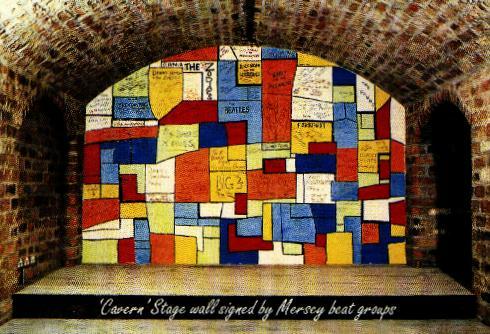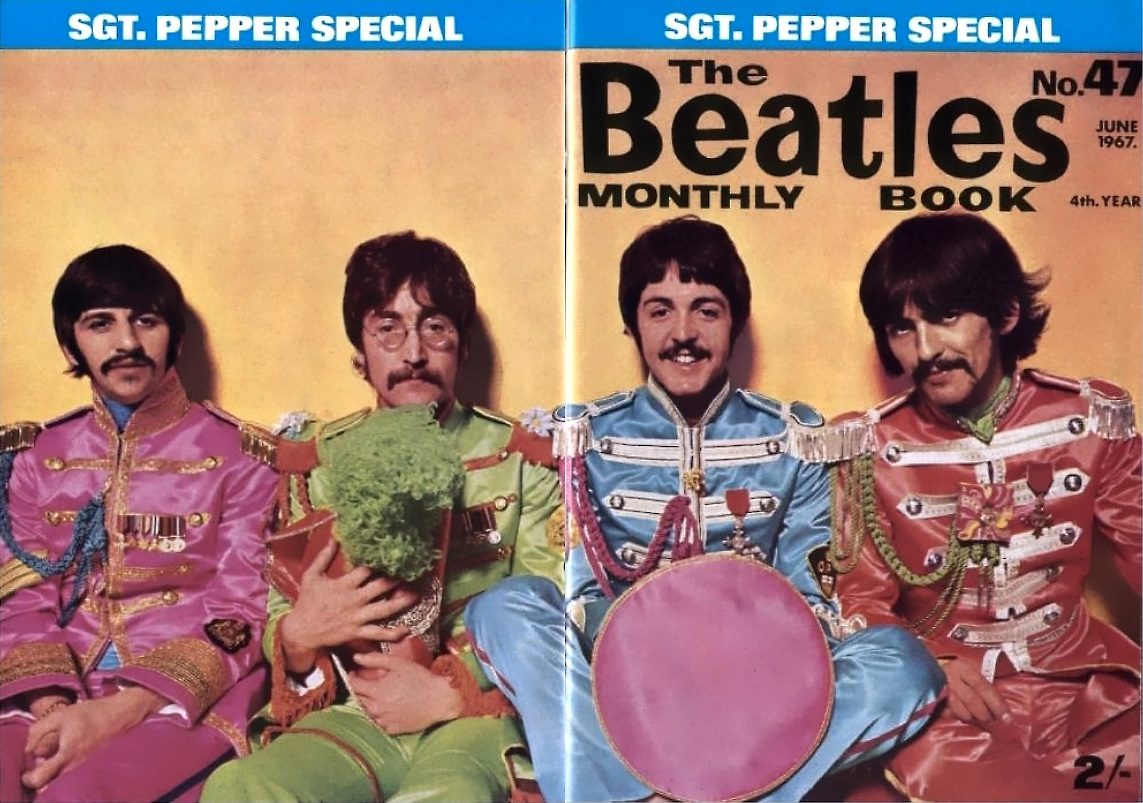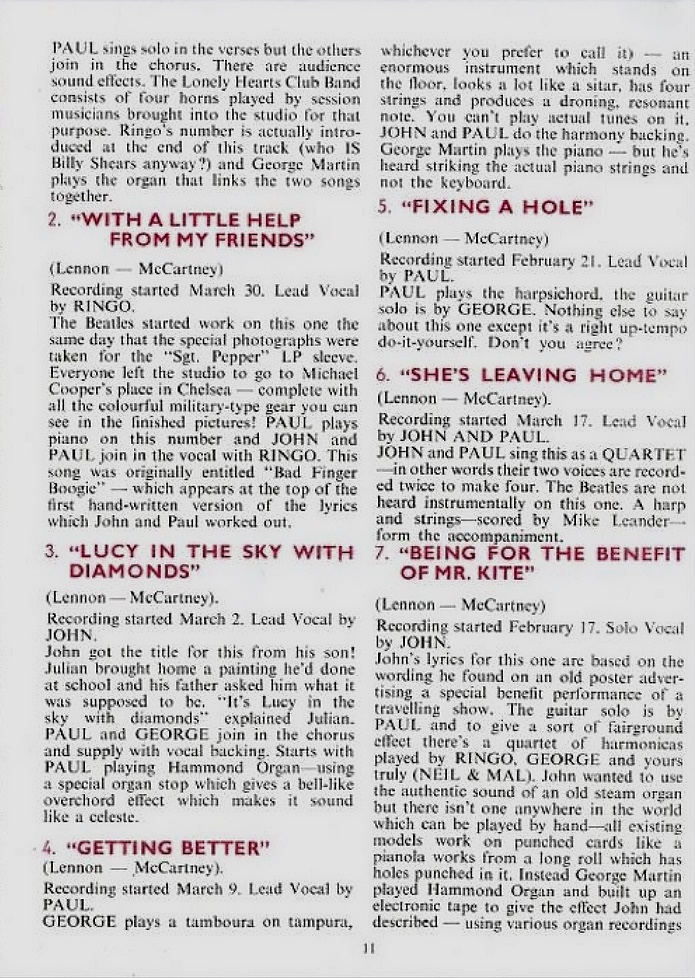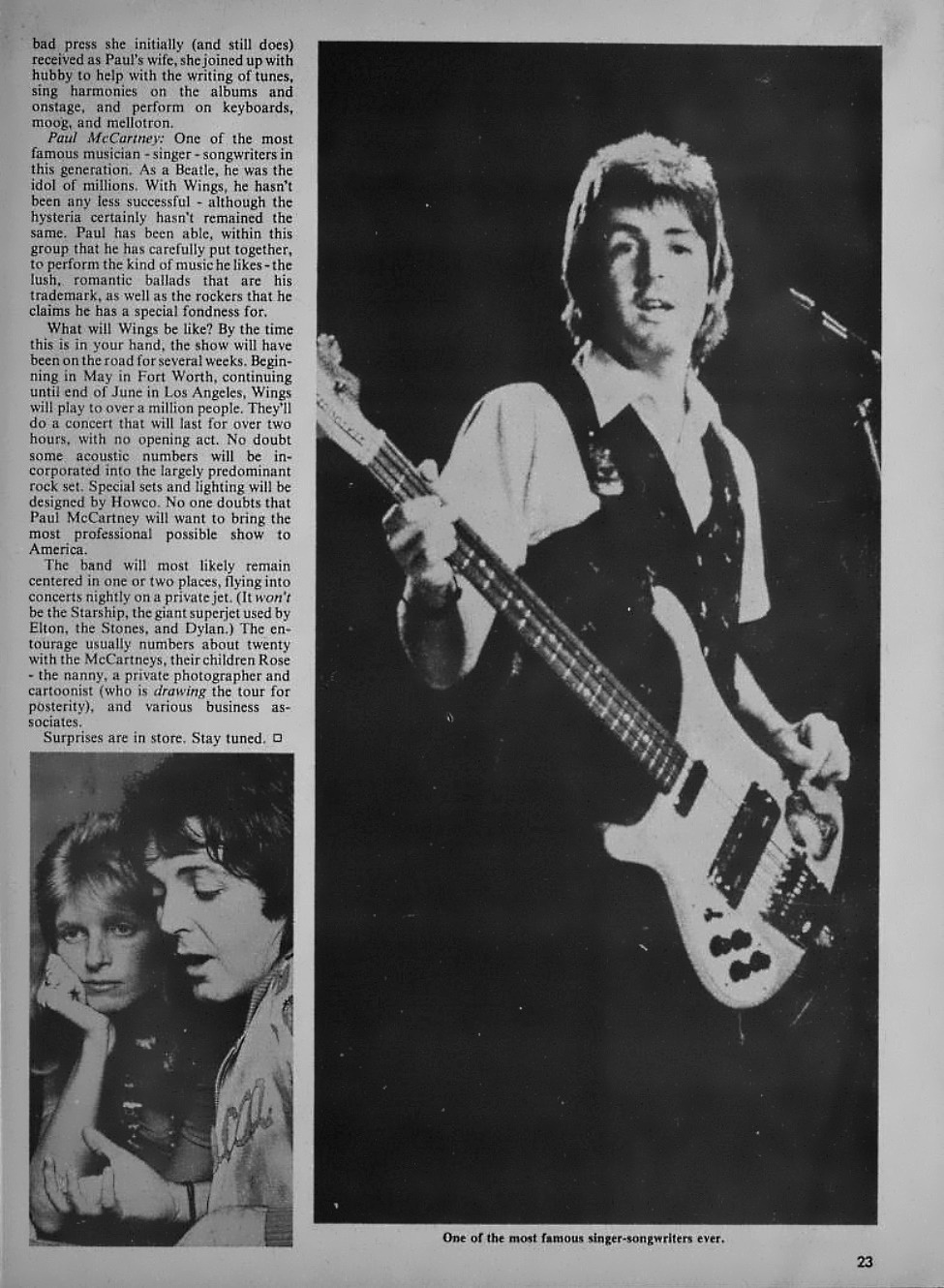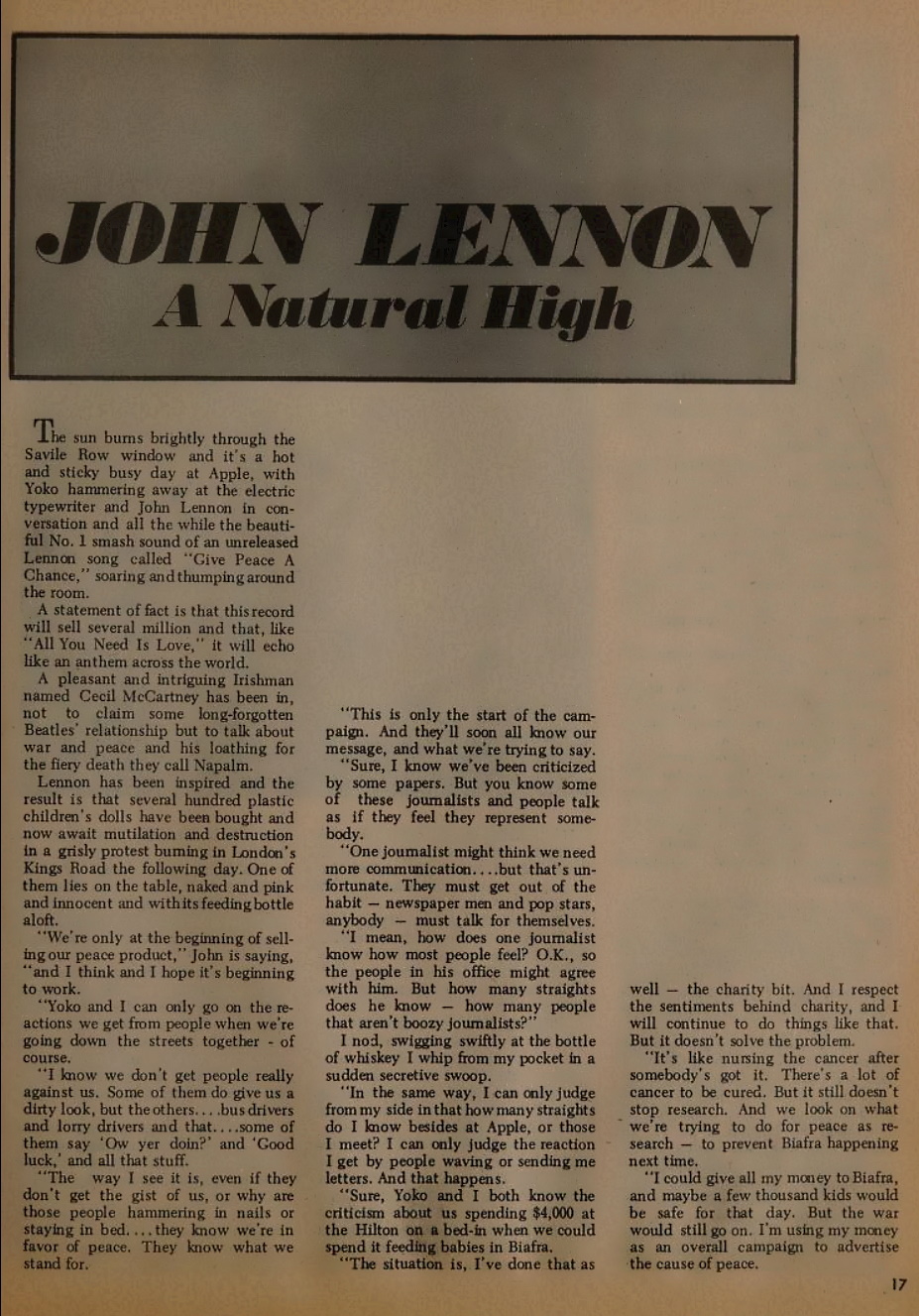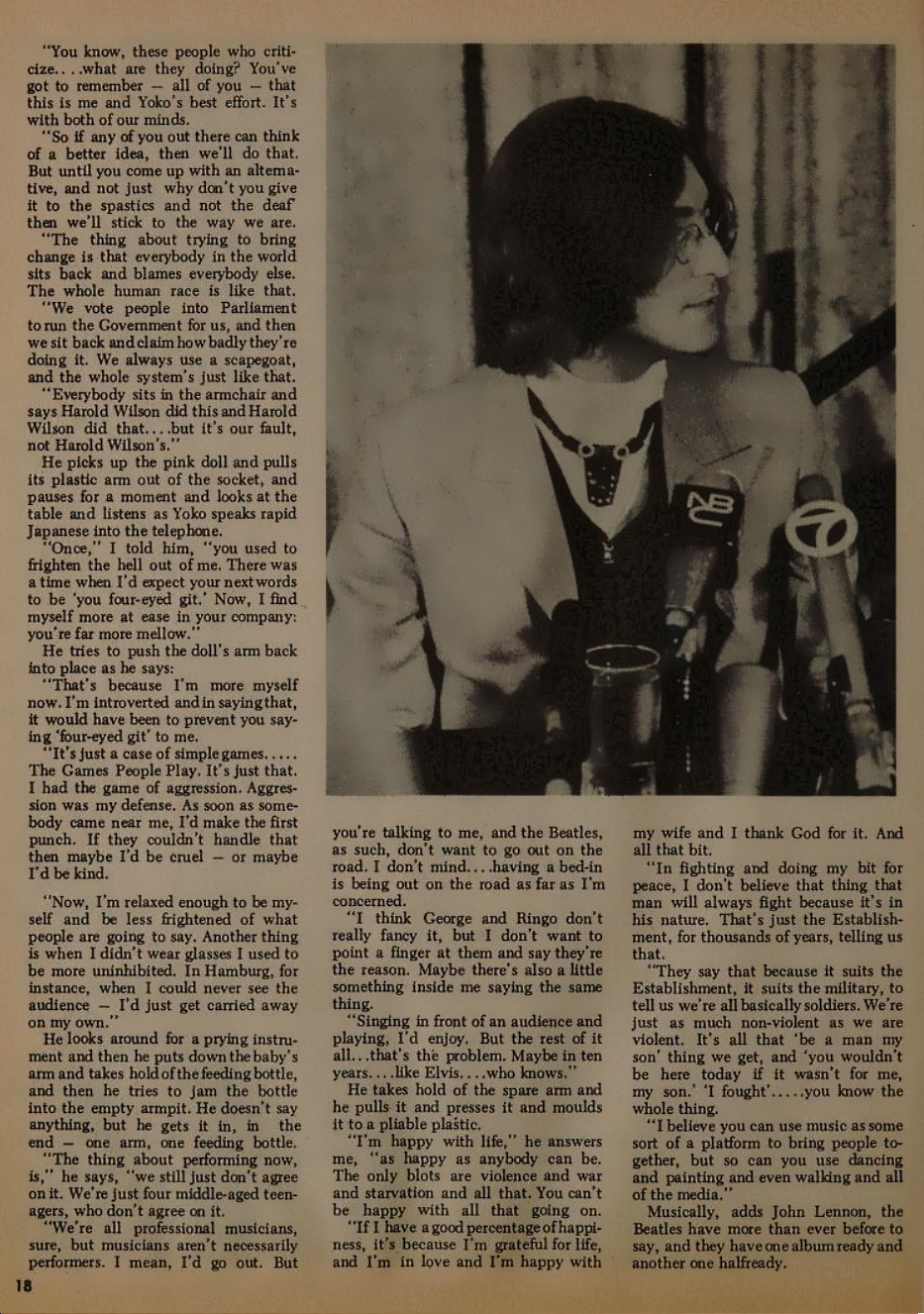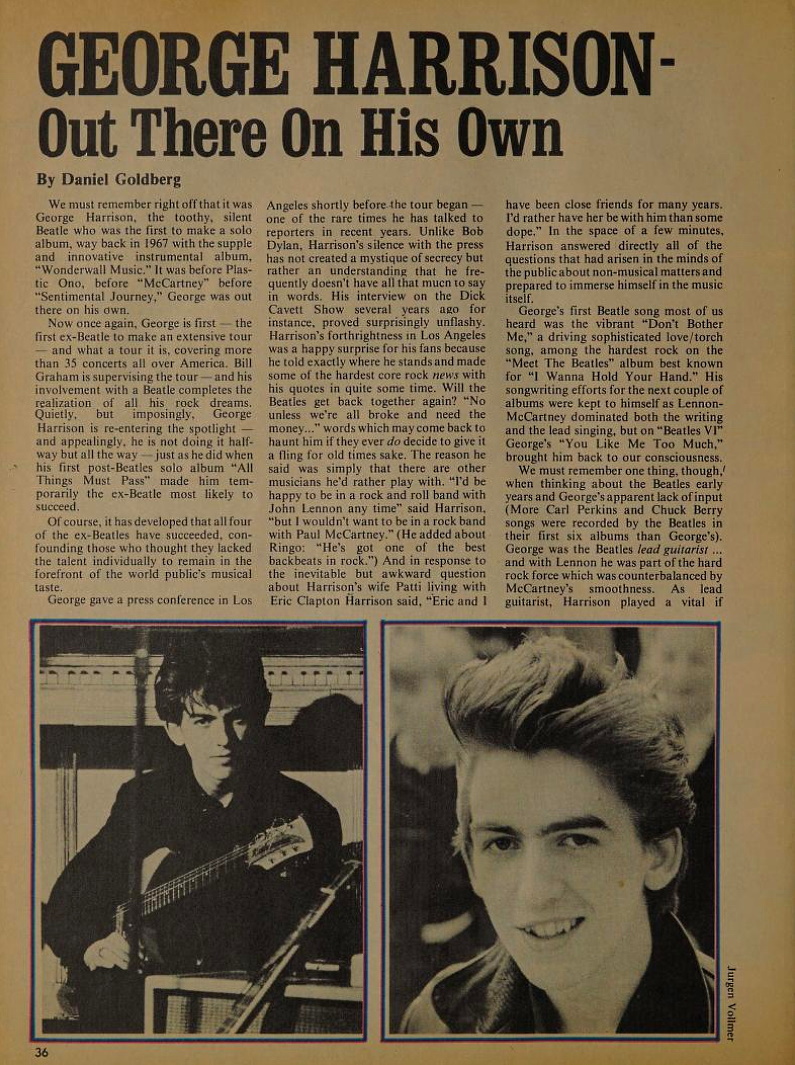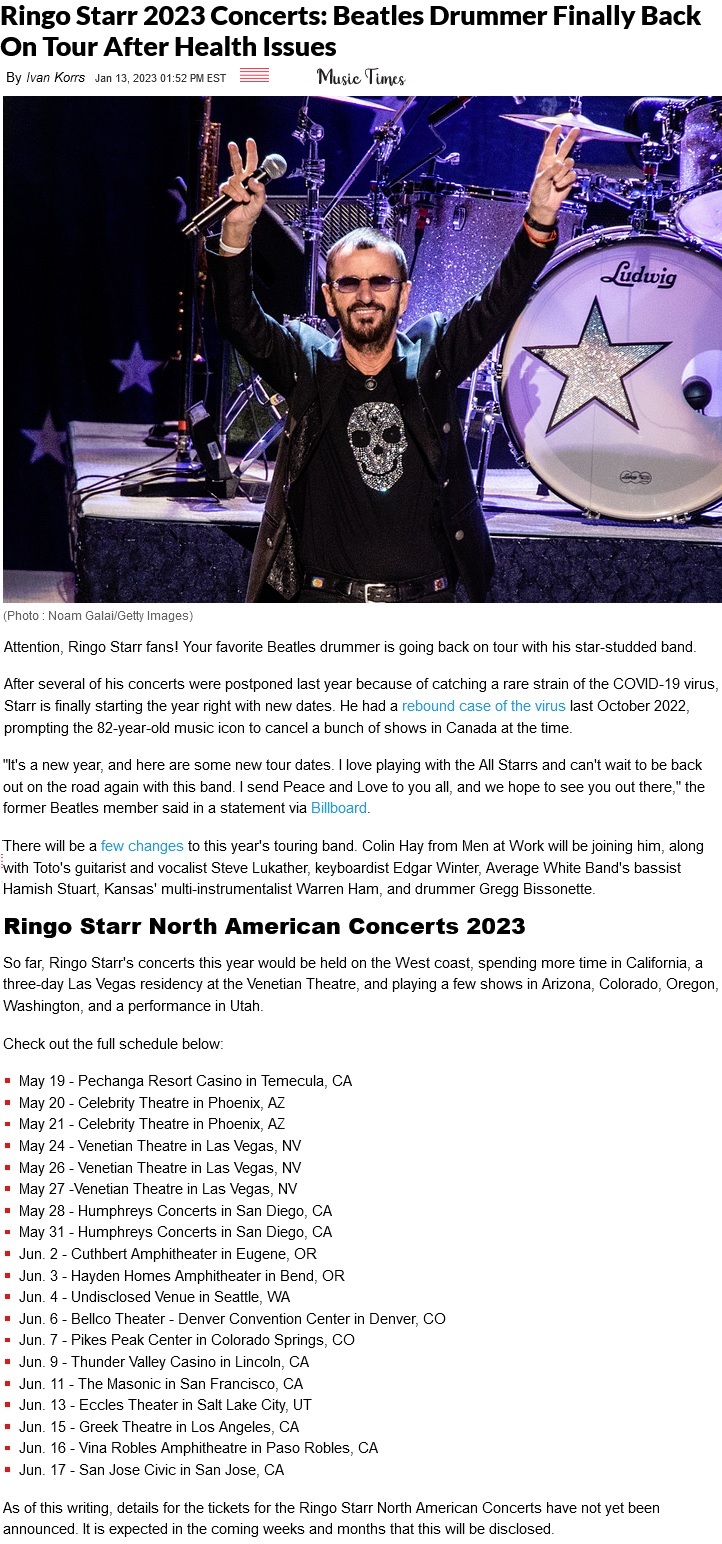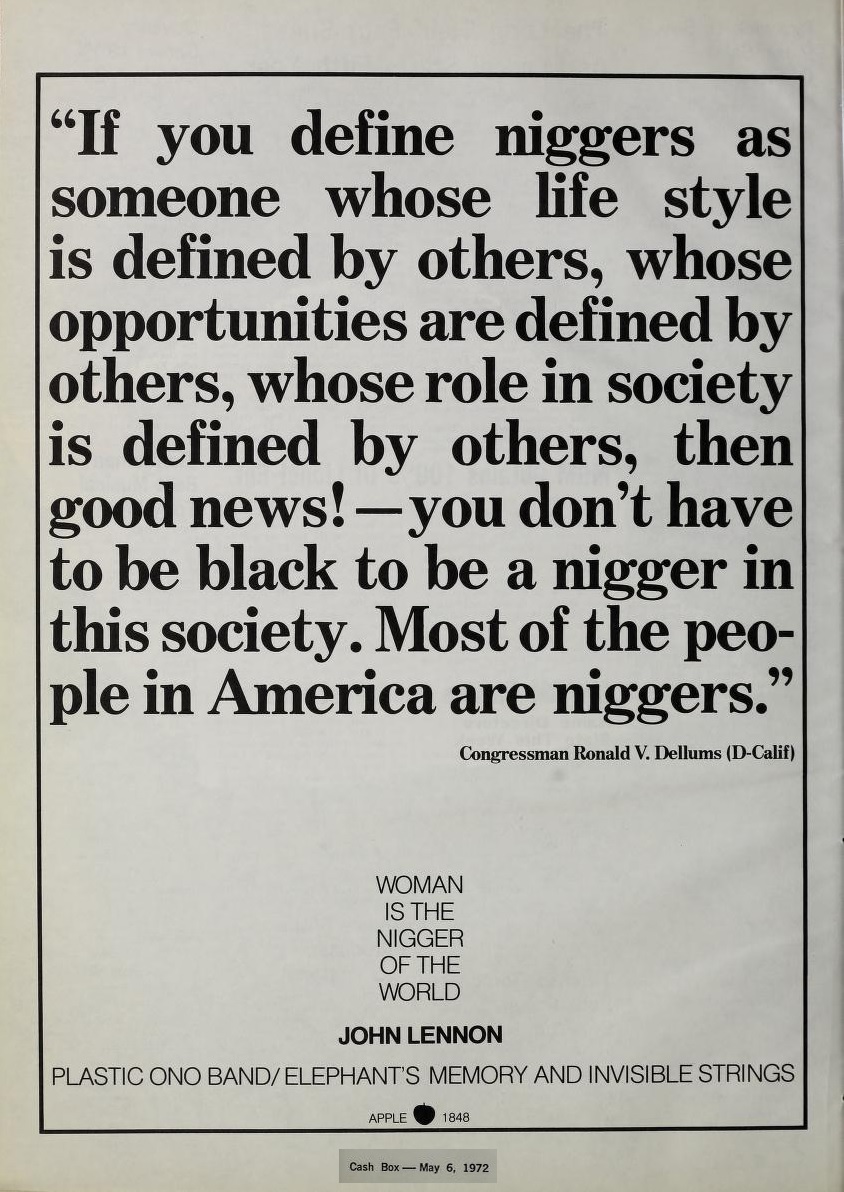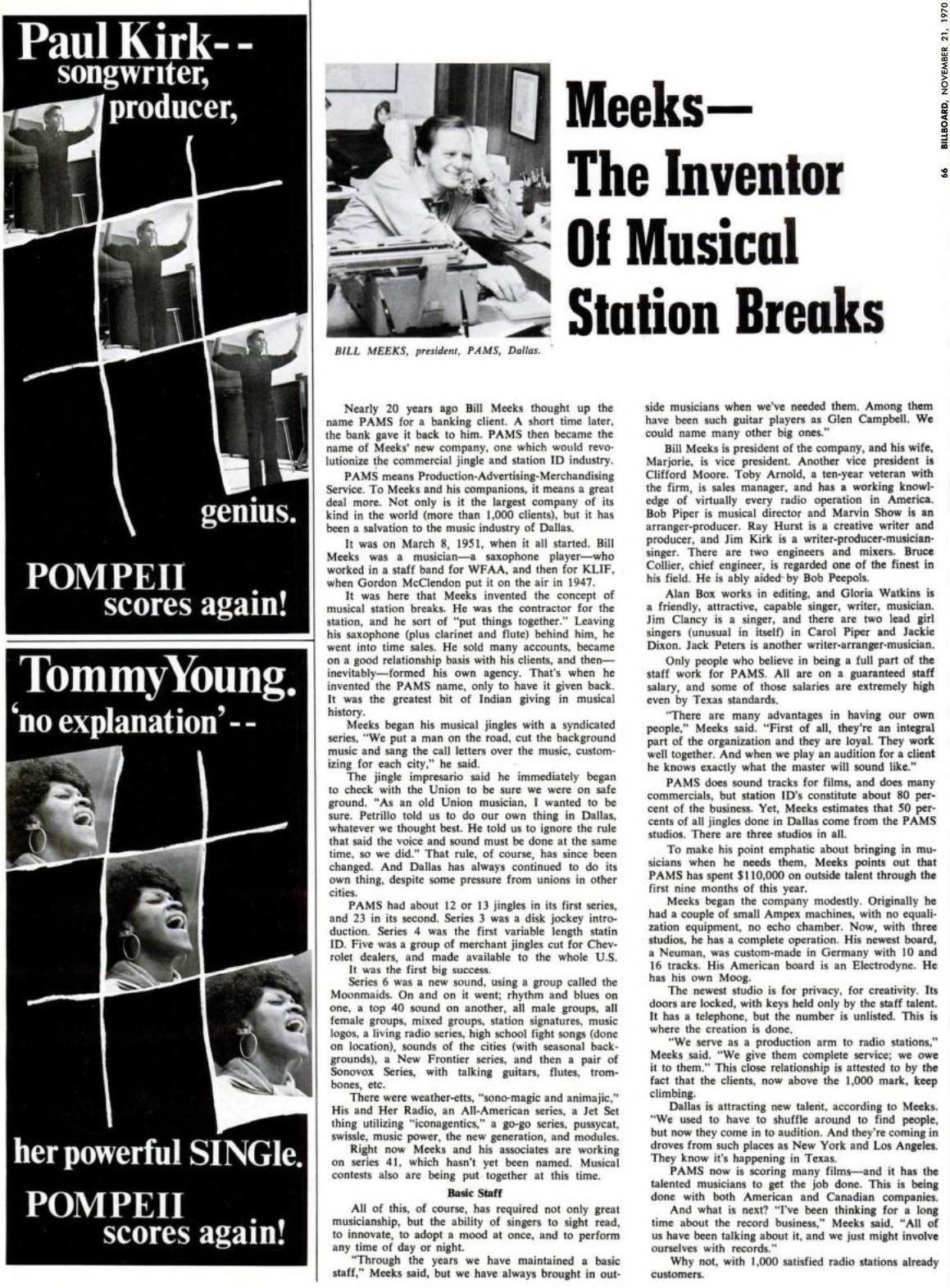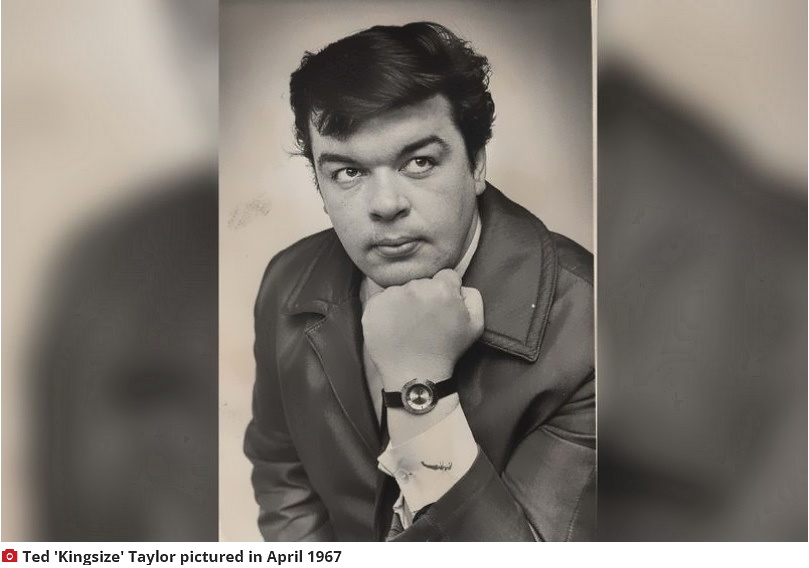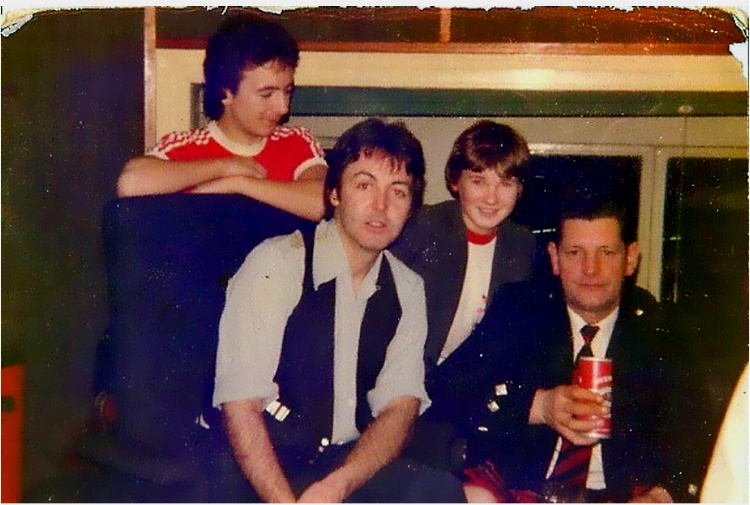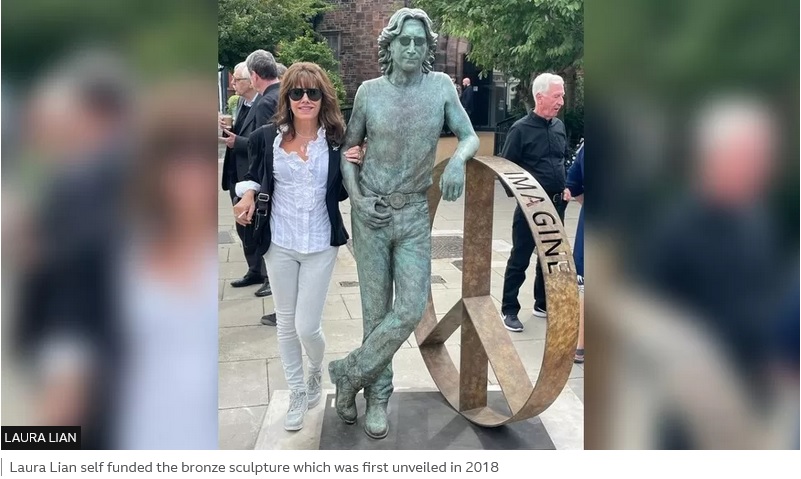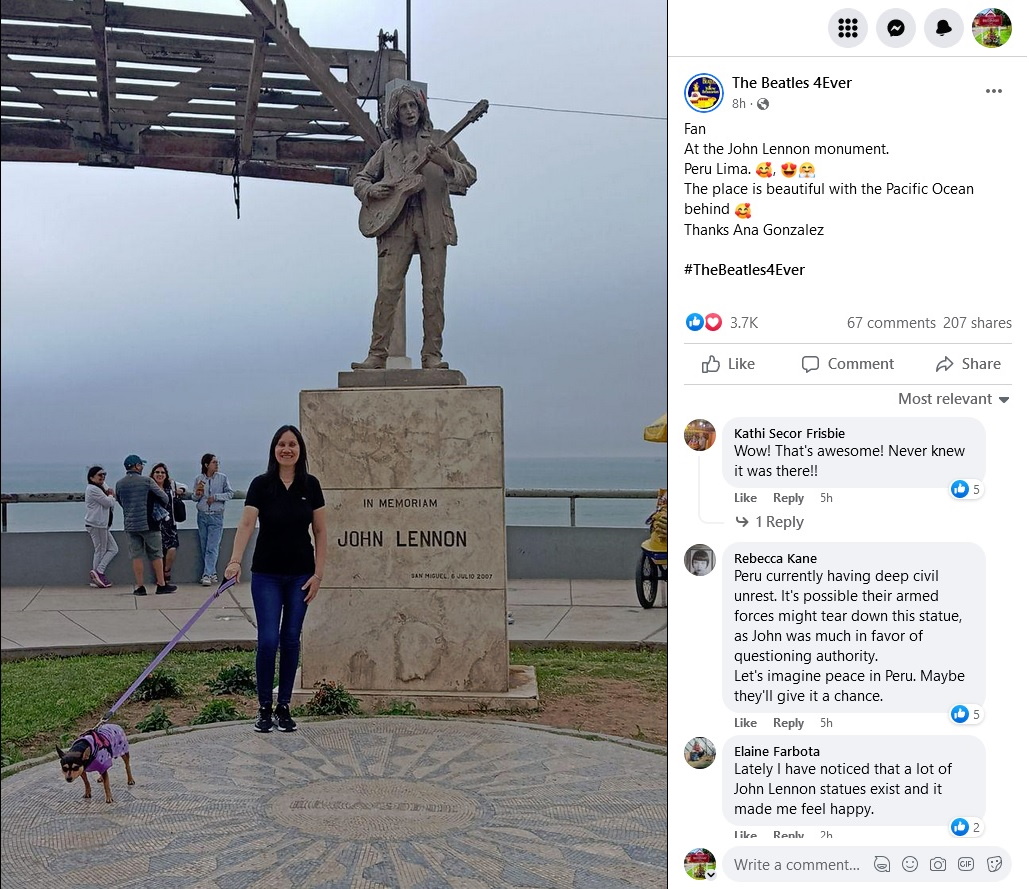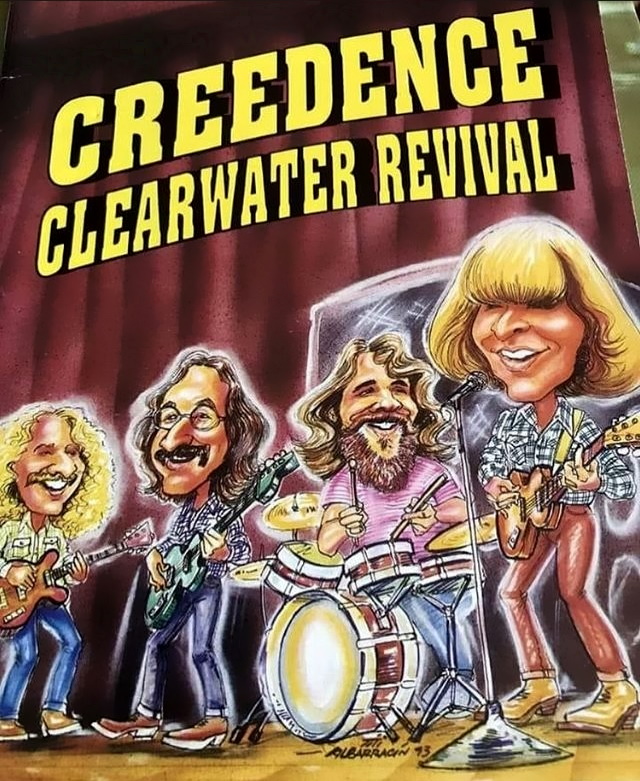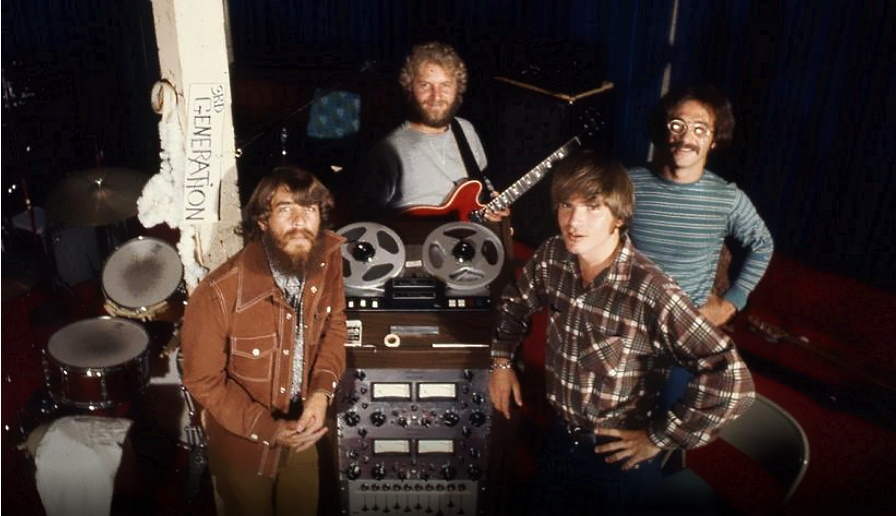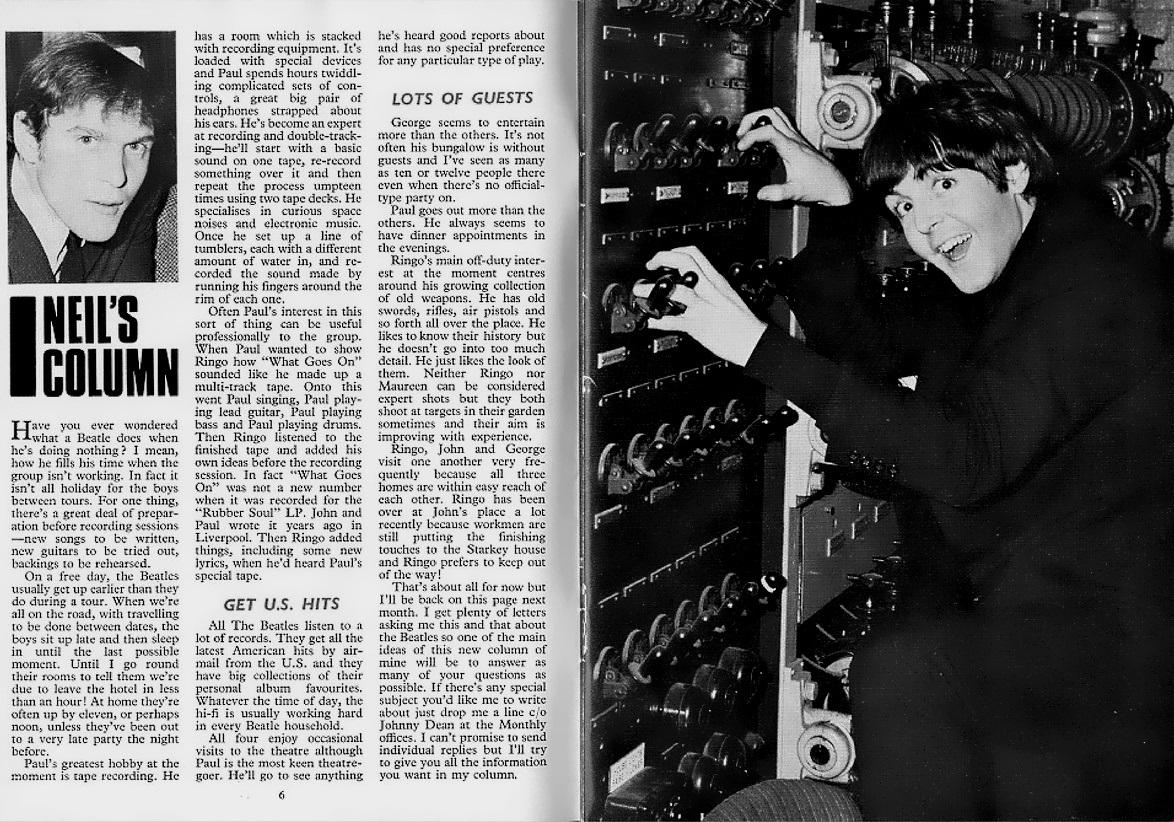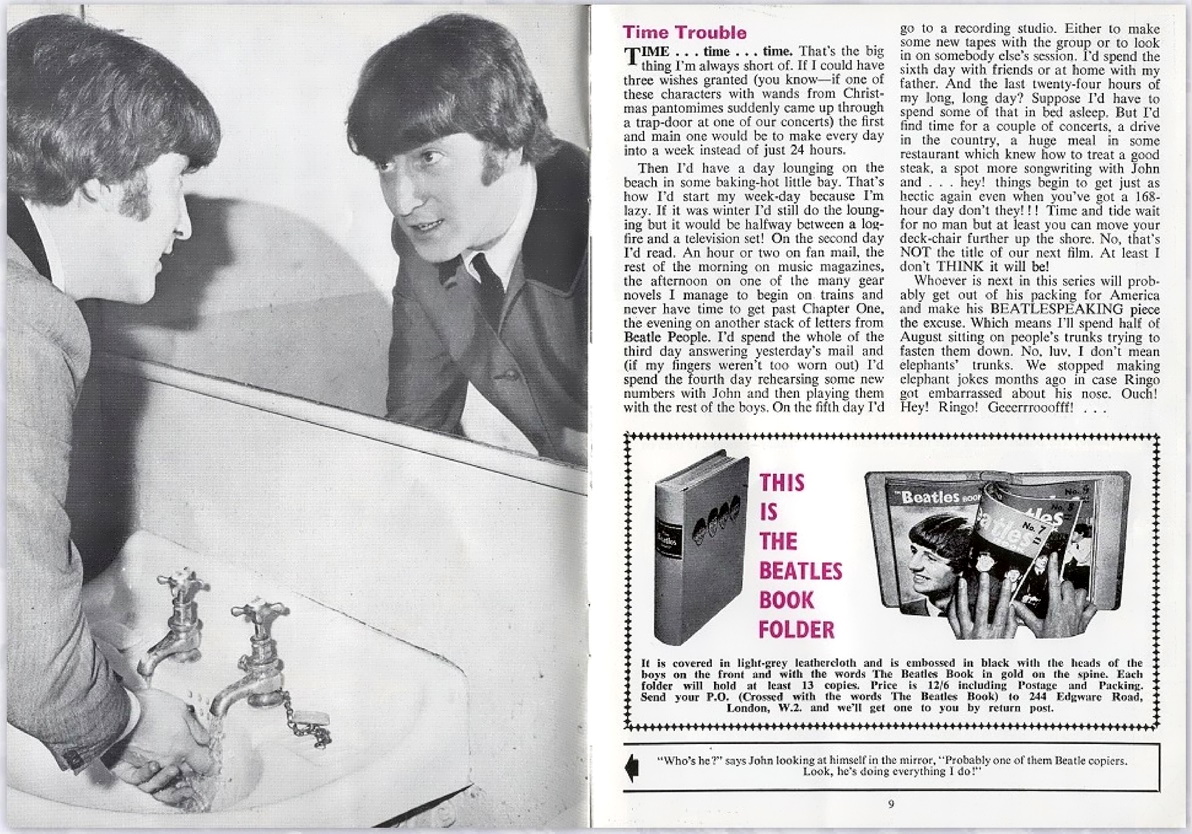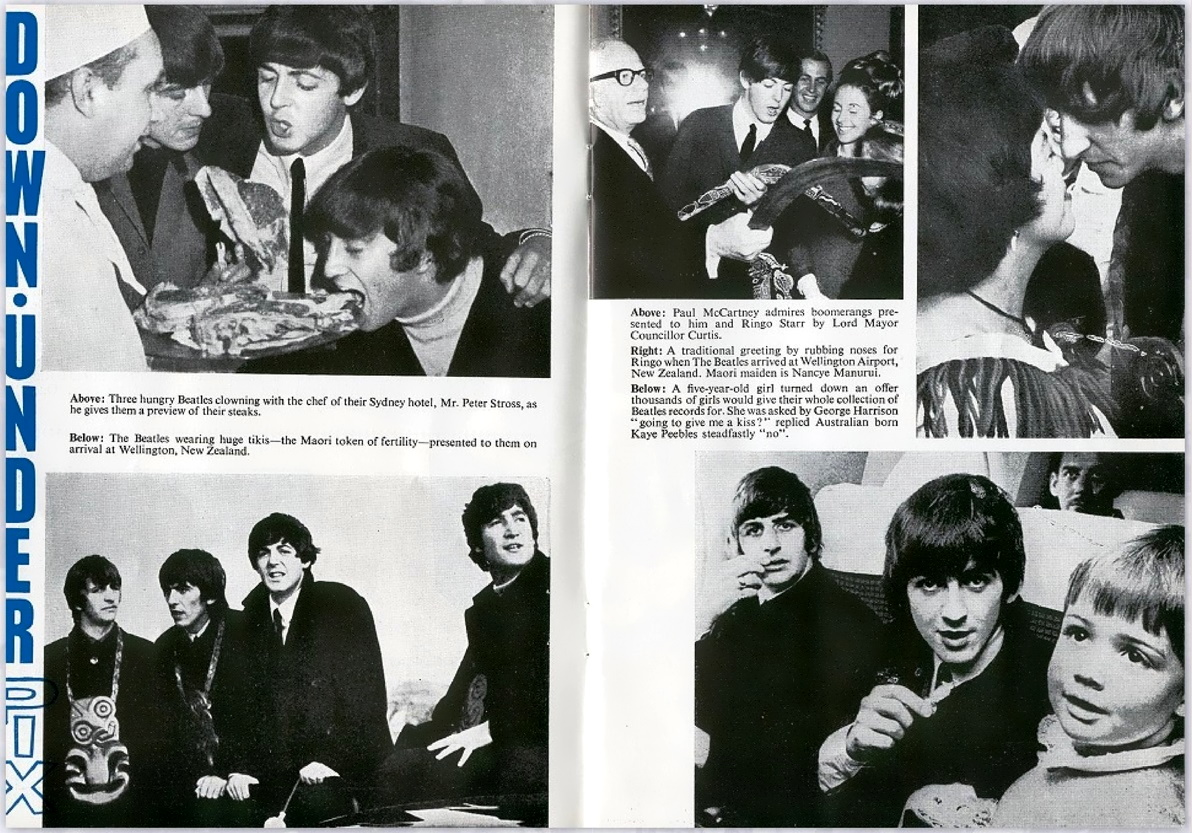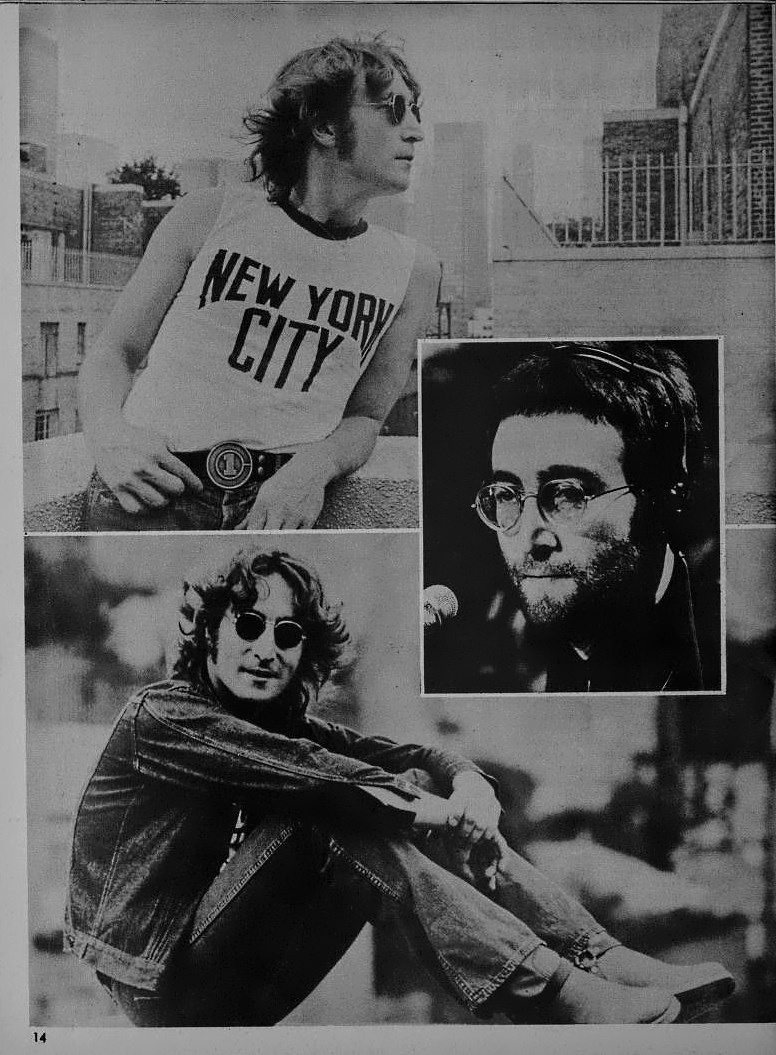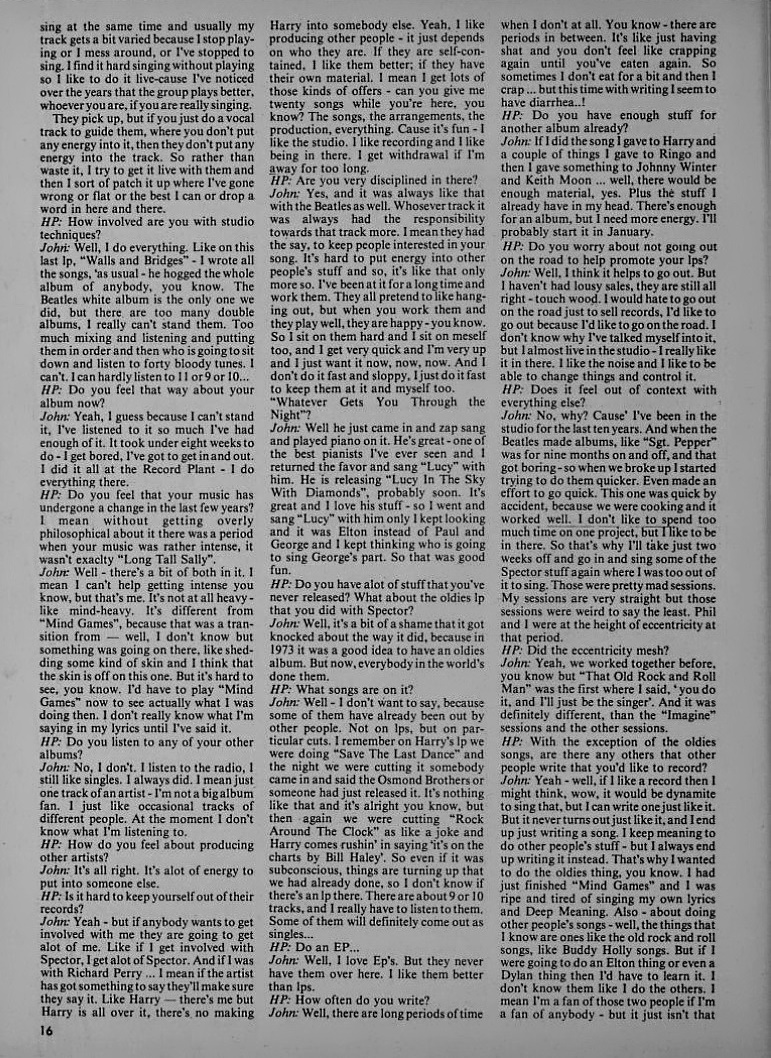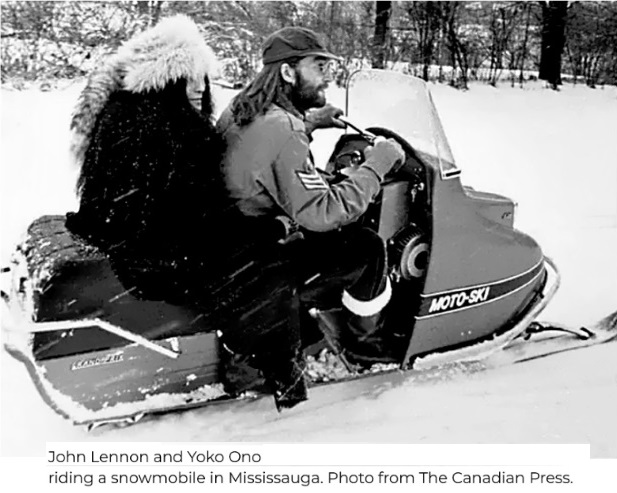|
|
||||||||||||||||||||||||||||||||||||||||||||||||||||||||||||||||||||||||||||||||||||||||||||||||||||||||||||||||||||||||||||||||||||||||||||||||||||||||||||||||||||||||||||||||||||||||||||||||||||||||||||||||||||||||||||||||||||||||||||||||||||||||||||||||||||||||||||||||||||||||||
|
The News Today
January 31, 2023 Denny Laine looks back on the breakthrough success and enduring legacy of Paul McCartney and Wings by Bill DeMain for Guitar World
1973 was the year Paul McCartney’s ragtag group, Wings, first scored Beatles-sized success. As guitarist Denny Laine recalls, they were no overnight success
“The first lineup of Wings was my favorite one,” Denny Laine says. “Something about those players together really gelled.”
With the benefit of hindsight and critical reassessment, the early incarnation of Paul and Linda McCartney’s group – rhythm guitarist /vocalist Laine, drummer Denny Seiwell and lead guitarist Henry McCullough – really does stand out. They were, as Laine modestly puts it, “a really good rock ’n’ roll band.”
But back in 1971-72, Wings was relentlessly maligned by the press. Rolling Stone called them “flaccid” and “aimless,” wondering why they even bothered to release their debut album, 1971’s Wild Life. Linda’s presence in the group galled critics to go further, writing what McCartney called “really savage stuff” about her. Much of this was fueled by the impossible bar raised by the Beatles. And rather than try to measure up to their legacy, Wings were willfully low-key and ramshackle, traveling in a beat-up van, turning up unannounced at colleges to play and never including any of the songs that made their leader one of the most famous musicians on the planet. But all that changed in 1973. Red Rose Speedway came out in April. The album – re-released in 2018 as a deluxe box set – marked the beginning of McCartney putting more polish on the band’s record-making. “We’d done more work,” Laine says, “and we were much tighter.” The album also gave Wings their first Number 1 single with My Love. Three months later, the rollicking James Bond theme Live and Let Die upped the ante even further. Nobody was laughing at Wings now. And then in December came their masterpiece, Band on the Run, made as a trio under trying circumstances in a run-down studio in Lagos, Nigeria.
Featuring Band on the Run, Let Me Roll It, Jet, Nineteen Hundred and Eighty-Five and Laine’s co-written gem No Words, it remains the band’s definitive statement. Though Laine says he “doesn’t do favorites,” the experience of making it is still a highlight of his 60-year career. “It was just the three of us, and the input I had makes it stand out as something special.”
Now 77, Laine is finishing a new album and preparing for an acoustic “Stories Behind the Songs” tour in early 2023 that will include material spanning his entire catalog – from the Moody Blues [he was a founding member of the Moodies] to Wings to his solo years.
“I can’t live without live work,” he says. “There’s no substitute for playing live and getting the feeling of connecting with an audience.” How do you think Wings evolved in the two years from Wild Life to Red Rose Speedway?
“Wild Life was very live-sounding – really, it was kind of what we were doing in our rehearsals. We weren’t trying to make a big-time album. It was very basic and raw, and to this day, a lot of people think that gives it more credibility than they did at the time. On Red Rose Speedway, we were more rehearsed and tighter, since we’d been on the road.
“So it was the first big production that we did, using Glyn Johns as a co-producer with Paul. It was meant to be a double album, and we did record more tracks than we needed. But it never came out that way. In fact, some of those tracks have been released on other packages, and are now on the box set.”
What were your go-to guitars and amps on Red Rose Speedway?
“At that time, my main guitars were a Fender Telecaster semi-hollow thinline with a maple neck and a sunburst Gibson acoustic jumbo, the SJ-200. I occasionally used a Strat, too. I had loads of other guitars, but I’ve always been the kind of person who’s stuck to one guitar. I never had five guitars on stage. My main amp was a Gibson Titan. It’s the model Chuck Berry had. But I also used a Vox AC30. That’s the amp I always used in the ’60s. Everybody loved their Vox back then.” Your rhythm parts in these songs are rarely just straight strumming. Take Big Barn Bed or the Hold Me Tight medley. There are lots of accents, held chords, rests and double-tracked arpeggiated chords. It’s very dynamic and intricate. Once you learned a song, can you describe how you’d approach the rhythm part?
“My memory of what I actually played on these things is gone. [Laughs] I can just about remember what guitar it was and that’s it. That said, if Paul writes a song on guitar, and it’s a very simple thing, I would probably just try to add to that. I wouldn’t be the main rhythm guitarist, because what the song needed was accompaniment.
“I was always pretty in with what Paul was playing, which probably makes it sound more like one part, probably. We did that a lot, where I would play lead parts in unison with him, like on Helen Wheels [from Band on the Run].
“If Paul was on piano, I’d have a bit more freedom to find my own guitar part. It was quite easy to do that with him. You have to remember – he and I grew up with the same musical tastes. We listened to all the same bits, so we have a very similar style.”
What do you remember about Henry McCullough’s classic guitar solo in My Love? Was it really as much of a surprise unveiling as Paul has said?
“I don’t know if it was a surprise. [Laughs] I played bass on that song, for a start. Like me, Paul always had an idea for what a solo should be. If I was playing it, I’d play something around the tune, you know? Paul had a part for Henry to play. And Henry said, ‘I have another idea, just leave it with me.’
“He’d obviously been sitting with it and worked out a little solo. Paul said, ‘Okay, that’s great,’ and it made the cut. It was something Paul hadn’t thought of playing. He generally sticks to the melody, whereas Henry added a bit more of a blues approach to it, which I think fitted it perfectly.”
The sessions started with Glyn Johns – whom Paul had worked with during the Beatles’ Get Back/Let It Be sessions in 1969 – co-producing, then Paul took over.
“There was a clash of some kind. I can’t really go into what the politics were, because I wasn’t involved in it. All I know is Paul likes to be his own producer. He might’ve had some experimental ideas that Glyn wasn’t willing to try. You know, putting the amps in little rooms to get certain sounds. I get it.
“I don’t really work with producers too well either. I worked with Denny Cordell in the Moody Blues days because he was a friend of mine. As far as I’m concerned, I didn’t notice any major tension on Red Rose Speedway. Glyn was just there at Olympic Studios. Then a few weeks later, he wasn’t. It was a little bit of a surprise to me.”
The background vocal blend of you, Paul and Linda is a hugely underappreciated part of the Wings sound. I’m thinking of the counter-melodies and “oohs” on When the Night and Get On the Right Thing, where your three voices are so complementary that they create this fourth sound. Can you talk about how you worked out arrangements and recorded those parts?
“Linda was a very musical person, but she was not a trained professional, if you want to call it that. She hadn’t done any live or studio work. So it took longer, but she could sing in tune, and you give her an idea, she could sing it. Either Paul or me would come up with a line for her to sing. We’d just sit there and say, ‘Where do we need harmonies?’ then work out the parts. Linda took to it quite quickly.
“But that blend became very popular and part of our sound. Even Michael Jackson asked Paul, ‘Who’s singing the harmonies there?’ ‘That’s Denny and Linda.’ There was a sound there that can’t be mimicked. It was a special part of Wings and I’m quite happy about that. It was nice to see Linda learning that stuff and how well she did. Again, on stage, she wasn’t experienced and sometimes had problems. But in the studio, she was spot on.”
Were you usually three around one mic?
“Yes. Often it was just me and Linda around the mic, unless it was a thing where Paul had to throw in a lead vocal and we’d sing around it. We doubled the parts a lot. Or we used ADT, the Automatic Double Tracking that the Beatles invented at EMI. It was a little machine that could simulate doubling. We always wanted to get that bigger, lush harmony sound. Everybody does it these days, but we were kind of pioneers in all that.”
For Band on the Run, what did you think when Paul and Linda decided to go to Lagos?
“I thought it was a great idea. I love going places where we’re going to be influenced by the local culture and music. Also, Ginger Baker had a studio there. We didn’t go there for that reason, but Ginger introduced us to some people, so we didn’t feel so alone [Note: Baker played percussion on Mamunia, shaking gravel in an old fire bucket]. The African drumming thing was a big influence on all of us.
“We were all into ethnic music, whether reggae or African or whatever. We sat around and looked at the map where all the EMI studios were and picked that one. ‘That sounds like it could be fun.’ Also, I think it might’ve been the only location available for when we wanted to go. I never had any negative feelings about going. I thought it was a nice change. There was a great energy there. Though we didn’t know it would be monsoon season. [Laughs]”
Denny Seiwell and Henry McCullough bailed on the trip at the last minute.
“As I say, I wasn’t involved in the politics, so I was just as surprised as anyone when they didn’t turn up [Note: Seiwell said McCartney had a falling out with McCullough over the guitarist’s refusal to play the same solos in every show]. I’ve been told that Paul had a talk with [Seiwell] the night before we went and he kind of decided he didn’t want to go.
“But he didn’t say that to me at the time. I don’t think their leaving had anything to do with the trip to Africa. It was something between them and Paul, and Paul said, ‘So what? It’s booked, we’re going anyway!’ and I said, ‘Okay, fine!’ That doesn’t throw me, that kind of thing. No big deal.” In what ways did suddenly being a three-piece shape the sound of Band on the Run?
“It didn’t really change, except that before, we would have done the backing tracks as a band. Now it was me on acoustic guitar or keyboards and Paul on drums. We would put the track down that way where he could get the drum part first. That’s how it worked on that album, and I think that’s how we got the specific feel for Band on the Run.
“Me and him had this kind of feel together musically. We slotted in well together. We could read each other, and that came from growing up on the same musical influences. Paul’s got a good sense of rhythm, and he doesn’t overplay, which I like.”
His drumming style is very idiosyncratic and recognizable.
“I think he got a lot of his style playing with Ringo, because Ringo’s a very basic drummer. He doesn’t overplay. He doesn’t try to show off and put in too many fills. So Paul just had that same approach to drumming. It’s all about having a good feel and working with the vocal. I remember on No Words, Paul forgot one of his drum entrances and came in a measure too late. But we left it in and kind of built the arrangement around that.”
Who played the famous opening lick on Band on the Run?
“Paul. It was his part. Some people think it’s doubled with me and him, but when I listen to it, it doesn’t sound that way. Usually we would double riffs. Band on the Run didn’t have a lot of guitar solos, except Nineteen Hundred and Eighty-Five, which I played the solo on. I very rarely did solos in Wings.”
You mentioned No Words, which is one of my favorites from the album. What do you recall about writing it?
“Paul was always trying to get me to write more. I didn’t, because he was very prolific, so I kind of left it up to him. On Band on the Run, he said, 'Have you got anything?'And I said, 'I’ve got these two different ideas,' thinking it might be two separate songs. Paul said, 'Let’s join them together.' Then he added the last part, the 'your burning love' section.
“You can do that with Paul. It’s hard to keep him out of a song once he gets going. [Laughs] He’ll always come up with something that works.”
What was the studio like in Lagos?
“They didn’t have anything. It was all hand-me-down equipment. Half of it wasn’t even rigged up. There was a door in the back that opened up into a record-pressing plant, with, like, 60 people working away. As for the equipment, obviously we’d brought our own guitars and amps. Again, like on Red Rose Speedway, I was using the Telecaster and the Gibson Jumbo.”
It was a time before plugins and loads of effects, so tone was much more reliant on the instrument, the amp and how it was mic’d. Do you feel there’s a difference in those vintage sounds compared to what’s available now with plugins?
“It’s all basically down to how you play it. Being a rhythm guitarist mostly, I was inspired by folk music, Spanish styles and rock ’n’ roll. I’m an accompanist, so I’ve learned to play as an accompanist. Whether it’s on Paul’s songs or my own, I get where to come in and where to go out. But as far as sounds go, we experimented with all kinds of things back then, because we had to. Natural echoes, mic placement. It was all real sounds.
“I’m still a great believer that it’s down to the way you play. The sounds come from the technique and your dynamics of how you play. You get the sound from your experience. That’s what you always have, so you don’t really need the new plugins and so on.
“I think what happens is that a lot of the stuff that came after the ’60s and ’70s is people trying to emulate that original sound, but with more modern techniques. You have to have the experience to get that sound. You can’t get it through a machine.”
What do you remember about the photoshoot for the album cover?
“Clive Arrowsmith, the photographer, ran out of film on the shoot, and that’s why it ended up with that sepia color. He’d put in a different kind of film and it was a fluke that he got that certain lighting. Sometimes life’s like that, where you come up with something special by accident. It was a fun day. Very up and positive.
“For me, the big surprise was finding out that [actor] Christopher Lee was a huge music fan and knew about records and stuff. The only direction was, ‘Okay, make believe you’ve been caught in the spotlights by the prison guards.’ Everybody looked one way, and funnily enough, I looked the other way. [Laughs]”
How do you feel about the legacy of Wings?
“I’m not trying to downplay it, but I’m actually surprised we’re that well-remembered. I’m just a normal musician who doesn’t really think about the fame side of it. That always surprises me, the fame side of it. For example, a lot of my solo stuff, I never really had a big hit, but then people will come up to me and say, ‘I’ve got all of your solo stuff. I know every song you’ve ever written.’
“It’s a compliment and it does give you a good feeling. You’ve gotten across to a lot more people than you thought you did. And it’s the same with Wings. We don’t think of it in terms of how famous we were or how many people we influenced until we meet the fans. But it’s all about music for me. It’s all about moving forward. We’re never really satisfied.
“Even when a lot of people say, ‘Oh, that’s the greatest album, or I love this or that,’ we don’t. We say, ‘We loved doing it, but in retrospect, I think I could’ve done that better.’ Or ‘I wish I hadn’t done that.’ You never stop creating, and therefore you’re never 100 percent satisfied. You can’t be. But when the finished product goes out and a lot of people are happy with it, that’s good enough encouragement for me.”
What are your latest projects?
“I’m working on new material for an album. Before the pandemic, I started doing solo acoustic shows and that started to go down really well and I was enjoying it. Now, starting in February [2023], I’m going to be doing the City Winery venues. New York, Nashville, all of them, and filling in shows in between.
“I can’t be strictly a studio guy. That’s how I came up, playing live. I think that’s the way the best records are made. You take that energy you get from performance and bring it into the studio. Then you come out with something good. It’s a hard thing to do in this business, but that’s what you need to do. It’s all about balance.”
 January 30, 2023 1982 - The Beatles 20th Anniversary | An Expensive But Great Year For Fans by Parlogram Auctions Collecting every single Beatles related release in 1982 was a very expensive affair. There were multiple singles, albums and box sets from all four solo members and The Beatles themselves. Being their 20th anniversary, there was no shortage of stories in the news from the past, present and future of the group. In this video, we cover all that and more from September to December that year and I guarantee that you'll learn something new and more importantly, enjoy it! "Klaus Voormann's Hand Painted Revolver Style Hofner Bass" Culled from "The Beatles Universe Features Page" on Facebook
 January 28, 2023 Ringo Starr claims his favourite John Lennon White Album song reunited The Beatles John Lennon wrote Sir Ringo Starr's favourite Beatles White Album song in India when "trying to reach God and feeling suicidal". by George Simpson for the Express, January 26, 2023
 January 26, 2023 Paul McCartney to Celebrate 81st Birthday With Book of Rare, Unseen 1964 Photos Taken by Him by Roger Friedman for Showbiz 411
Paul McCartney was in the eye of the storm, Beatlemania, in 1964 when his group took over the world.
Now it seems he’s found a treasure trove of photos he took on a 35mm camera when it all happened. A book is coming called “Eyes of the Storm” on June 13th, five days before Sir Paul’s 81st birthday.
The photos were taken in six cities: New York, Washington, London, Liverpool, Miami, and Paris.
There are 275 pictures. The book will have an introduction by Paul, plus essays by Jill Lepore and Nicholas Cullinan.
Paul is following the lead of his bandmate, Ringo Starr, who’s published several tomes of pictures, postcards and other Beatles memorabilia.
No price yet for the book. But Paul’s two volume “The Lyrics” sold for $150 last year and was a best seller.
 January 24, 2023 Ringo Starr drums on Ian Hunter's new single "Bed of Roses" "Bed Of Roses" Ringo Starr: Drums Tony Shanahan: Bass Mike Campbell: Acoustic and Electric Rhythm Guitars, Slide Guitar, Mandolin Andy Burton: Organ Rich Pagano: Tambourine Andy York: Background Vocals Ian Hunter: Piano Ian Hunter's new album: "Defiance Part 1" is coming April 21, 2023!
“It was a fluke,” Ian Hunter says. “This was not planned. Really, I’m serious. I really couldn’t believe some of them. I mean, it’s amazing what’s happened. It’s been such a buzz.” “Everybody’s sitting around,” says Hunter. “It’s Covid. Nobody’s going anywhere. We started sending them out. Slash started doing something. Robert Trujillo from Metallica. Ringo Starr, Mike Campbell. Joe Elliott is on a few tracks. Johnny Depp said ‘Jeff Beck’s with me and we’d like to do a couple of songs.’ I know Todd Rundgren, I toured with Todd way back, he’s done an amazing job. Billy Gibbons. Billy Bob Thornton and JD Andrew from The Boxmasters. It’s never ending. I mean, every day we’d get a phone call, this guy wants to do it, that guy wants to do it. It was like, I can’t believe this.” “There are a lot of reasons for calling this album DEFIANCE,” says Ian Hunter. “It’s like, people my age shouldn’t be making records, blah, blah, blah. But we’ve still got a bit left.” Click here for the complete track listing.  January 23, 2023
 January 22, 2023 Sgt. Pepper Special with written comments from Mal Evans and Neil Aspinall
From Disc and Music Echo, some promotional information about Sgt. Pepper
 January 20, 2023 Flashback: Wings Over America article from Hit Parader, September 1976
 January 19, 2023 Flashback: "John Lennon A Natural High" by Alan Smith for Hit Parader magazine, January 1970
 January 18, 2023 Brian Wilson’s Reaction to ‘I Get Around’ Surpassing the Beatles on the Music Charts by Julia Dzurillay for Showbiz CheatSheet Originally published on January 16, 2023 The Beach Boys became one of the most popular groups in the early 1960s — topping the music charts alongside the Beatles. Here’s what Brian Wilson said about their first original that reached No. 1, “I Get Around” on Billboard’s Pop chart. Brian Wilson and Mike Love wrote ‘I Get Around’ by the Beach Boys
by Brian Wilson and Mike Love. The “doo-wop” surf rock track was initially included on the 1964 album All Summer Long and further detailed this group’s affinity for cars. “I’m gettin’ bugged driving up and down the same old strip,” the first verse states. “I gotta find a new place where the kids are hip / My buddies and me are getting real well known / Yeah, the bad guys know us and they leave us alone.” Brian Wilson said ‘something changed on the chart’ when ‘I Get Around’ was released In I Am Brian Wilson: A Memoir, the songwriter detailed his experience releasing music with the Beach Boys. Even some of their early hits were played on the radio and jukeboxes, according to Al Jardine. “I Get Around,” however, was a turning point for the group.
“Then in July, something changed on the chart,” Wilson wrote. “The top song wasn’t by the Dixie cups or Mary Wells or the Beatles. It was by us… I couldn’t believe it. It wasn’t just Sweden anymore. ‘I Get Around’ was also our first gold record. And it wasn’t just how many people were buying our records. It was how people were talking about our records.” “They made us out to be the next great pop act after the Beatles, though we had been putting records on the charts for years,” he continued. “And some people were saying we were even better, that our songs were more interesting or sophisticated or created more positive energy.” “I Get Around” remains one of the most popular songs by the Beach Boys. In 2012, it was added to 50 Big Ones: Greatest Hits. Since its Spotify debut, the track has earned over 145 million plays. This was also the song showcased on the Ed Sullivan Show — the same television program that confirmed the Beatles’ popularity in America. Were the Beach Boys and the Beatles friends? In the same memoir, Brian Wilson confirmed his friendship with Paul McCartney of the Beatles, with the singer inducting him into the Songwriters’ Hall of Fame. John Lennon and George Harrison once showed up at Jardine’s hotel room to discuss transcendental meditation. Despite this overlap in the community, the Beatles and the Beach Boys never collaborated on music. Jardine specifically mentioned wanting to work with the “Let It Be” band. Still, the Beach Boys went on to appear in Full House while the Beatles branched out to work on solo projects. The following is an advertisement that appeared in Billboard, June 12, 1965, revealed that George Martin produced the new single from Billy J. Kramer and the Dakotas "Trains and Boats and Planes"
 January 17, 2023 Flashback: "George Harrison - Out There On His Own" by Daniel Goldberg for Hit Parader Magazine, April 1975
 January 15, 2023 Creedence Clearwater Revival's John Fogerty wins music rights by Sam Cabral for the BBC
John Fogerty ain't no fortunate one, but after this week, the Rock and Roll Hall of Famer may be feeling like one. Following a 50-year legal battle, the founding member of Creedence Clearwater Revival now owns the global publishing rights to the iconic rock band's songs. It came after Mr Fogerty, 77, bought a majority stake in the rights to the band's catalogue from Concord Records, which has owned the rights since 2004. "As of January this year, I own my own songs again," he wrote on Twitter. "This is something I thought would never be a possibility. After 50 years, I am finally reunited with my songs." Mr Fogerty owns the rights to his solo material, but his new majority interest gives him control - for the first time - over 65 Creedence Clearwater Revival copyrights, including hits like Bad Moon Rising, Have You Ever Seen The Rain, Proud Mary and Fortunate Son.
The rocker founded the group in 1968, alongside his older brother Tom, Doug Clifford and Stu Cook, and was its lead singer, lead guitarist and principal songwriter.
The California-born quartet notched nine top-10 singles and five top-10 albums on the Billboard charts, reportedly even besting the Beatles in album sales in the year 1969.
They disbanded in 1972 and were inducted into the Rock and Roll Hall of Fame in 1993.
But decades of its frontman's life have been dominated by the protracted dispute that began after late music mogul Saul Zaentz signed a teenage Mr Fogerty and his group to his Fantasy Records label in the mid-1960s.
Fantasy owned the group's distribution and publishing rights. Mr Fogerty, who traded insults and lawsuits with Zaentz, also claims he lost money because the label misled him with bad investments and absorbed his earnings from royalties.
The label was sold to Concord in 2004, which quickly reinstated - and increased - the royalties Mr Fogerty had not received in some 25 years.
The company's recently announced deal with the musician comes at an undisclosed sum. It will see Concord retain the CCR master recordings already in its catalogue and continue to administer Mr Fogerty's share of the catalogue for an unspecified amount of time.
"I'm the dad [of these songs]. I created them," the rocker told Billboard on Thursday. "They never should have been taken away in the first place."
Canadian Songstress Anne Murray covers "You Won't See Me" - became a smash hit in April 1974
 January 14, 2023 John Lennon's shocking promotional advertisement for "Woman Is The Nigger of the World" as found in the May 6, 1972 edition of Cash Box...
 January 13, 2023 Paul McCartney: Jeff Beck played some of the best British guitar music ever The Who’s Pete Townshend and Roger Daltrey were among the rock legends to pay tribute to the guitarist who died on Tuesday. by Charlotte McLaughlin for the Evening Standard Sir Paul McCartney said Jeff Beck “played some of the best guitar music ever to come out of Great Britain” following the 78-year-old rock guitarist’s death.
The former member of the Beatles, Sir Paul, 80, called him a “lovely man with a wicked sense of humour” as Queen’s Sir Brian May and the Who’s Pete Townshend and Roger Daltrey, among other rock legends, paid tribute to one of their own.
Beck, who died after contracting bacterial meningitis, is known for his work with the Yardbirds and the Jeff Beck Group and performed alongside musical heavyweights including Eric Clapton and Jimmy Page.
In a post on Instagram on Thursday, Sir Paul said: “Jeff Beck was a lovely man with a wicked sense of humour who played some of the best guitar music ever to come out of Great Britain.
Cash Box Top Solo Beatle Singles for December 29, 1973: 1 - Mind Games by John Lennon 2 - Helen Wheels by Paul McCartney 3 - You're Sixteen by Ringo Starr 4 - Photograph by Ringo Starr
 January 12, 2023 ‘Please Please Me’: Remembering The Beatles’ Second Single Released in January 1963, The Beatles’ ‘Please Please Me,’ was a transatlantic smash hit, but not quite as successful as many people now imagine. by Richard Havers for udiscovermusic.com
It’s one of those questions to which everyone is (pretty) sure they know the answer. What was The Beatles’ first No.1 on the official UK charts?
Just about everyone knows that “Love Me Do,” their first single, did OK on the charts, but didn’t reach the coveted top spot. So the answer has to be… “Please Please Me” recorded at the end of November 1962 and released as their second single on January 11, 1963. But the truth is, according to the Record Retailer magazine chart, “Please Please Me” only made No.2. What was the confusion about? Well, the good old BBC did place the song at No.1 on their chart, which was determined by an average of various UK charts published in the New Musical Express, Record Mirror, and other British pop papers.
It was on Monday, November 26, 1962, following a Sunday evening gig at Liverpool’s Cavern Club, that The Beatles headed to London to record “Please Please Me,” along with the B-side “Ask Me Why.” The next day, The Beatles were at the BBC’s Paris Studio, in London’s Lower Regent Street, for their first-ever London appearance on the UK’s national radio station. Released on January 11, “Please Please Me” charted a little over a week later, peaking at No. 2 in late February, where it stayed for two weeks and it made the No.2 slot again on March 16 for a single week.
In America, Capitol Records turned down the opportunity to release The Beatles’ first two singles, and so a deal was done with Vee-Jay, a US label whose main claim to fame was that they had The Four Seasons on their label. A few weeks before the impending arrival of The Beatles in New York to appear on Ed Sullivan’s Show in February 1964, Vee-Jay reissued “Please Please Me” with “From Me to You” on the B-side (having originally released “Please Please Me” in February 1963 that at the time did not perform well).
When The Beatles set foot on American soil, at New York’s John F. Kennedy International Airport on Friday, February 7, 1964, it marked the beginning of what has come to be called, “the British invasion.” The following morning The Beatles, minus George who was unwell, did a press photo-call in New York’s Central Park. After lunch, there were rehearsals for The Ed Sullivan Show, and the band’s road manager, Neil Aspinall, stood in for George at a TV camera call.
The Ed Sullivan Show was broadcast from Studio 50 on Broadway and West 53rd Street in Manhattan and The Beatles taped what became their third appearance on the show the following day. On The Beatles 1’s DVD and Blu-ray the clip of the band performing, “Please Please Me” is taken from the show that was transmitted on Sunday, February 23.
On the evening following the afternoon’s videotaped session, The Beatles performed live to a studio audience of 728 people. More significantly, the Sunday evening show was seen by 73 million Americans in over 23 million homes. It remains one of the most-watched broadcasts in TV history. Brian Epstein’s deal with the show resulted in The Beatles being seen on American TV on three consecutive Sunday nights – an unprecedented PR opportunity.
Their performance of “Please Please Me” was a significant reason behind the single peaking at No.3 on the week of March 21, 1964. Two weeks later “Please Please Me” was at No.5 on the charts, but in the four places above it were, “I Want To Hold Your Hand” at No.4, “She Loves You” at No.3, “Twist and Shout” at No.2 and “Can’t Buy Me Love” at No.1.  January 11, 2023 "Bill Meeks ─ The Inventor of Musical Station Breaks" by Billboard Magazine, November 21, 1970
Promotional spread by Brian Epstein and the Saville Theatre for Disc and Music Echo in 1966
 January 10, 2023 Two articles by Tony Barrow from the August 1963 edition of The Beatles Monthly Book: "Brian Epstein and Sir George Martin"
 January 9, 2023 Flashback to news coverage on the Beatles break-up "Beatles─the final rift" by Ray Connolly for the Evening Standard, December 31, 1970
 January 7, 2023 Tributes paid to 'genuine superstar' who shared stage with The Beatles Ted 'Kingsize' Taylor was a key player in the Mersybeat area by James McNeill for the Liverpool Echo
Tributes have been paid to legendary Southport musician Ted 'Kingsize' Taylor after he died aged 83.
Ted along with his band The Dominoes was a contemporary of The Beatles, often sharing the bill with them in both Liverpool and Hamburg. 'Kingsize', who gained his name due to his imposing 6ft 5in frame, left the music industry in the mid-60s and for more than 30 years ran a butcher’s shop.
In a tribute on Facebook, Ted who shared the stage with stars such as Jerry Lee Lewis, Ray Charles, and Fats Domino has been described as a "genuine superstar" who was "rock and roll" until the end.
The Dominoes were formed in north Liverpool, in 1957, and over the next two years, Taylor developed a reputation as one of the most well-known rock and roll singers in Merseyside.
They first performed at The Cavern Club in January 1961, when they featured 17-year-old singer Cilla White, who would later go on to be known as Cilla Black, who sang regularly with the band until 1962.
A post on his Facebook page on January 2 read: "Good night folks, I’m undertaking my last journey and may not be back for a while. I’ll remember each and every one of you that made my life so special, so many wonderful memories to take with me.
"Love to my son Mark and Alex for helping me and loving me. God bless you all and see you soon.”
In the summer of 1962, the band, without Cilla, went to Hamburg, where they began making regular appearances at the Star Club. Ringo Starr turned down the opportunity to join having been offered more money to join The Beatles.
After recording a solo single for Decca in London in 1964, Somebody’s Always Tryin”, with Led Zeppelin guitarist Jimmy Page, he gave up the music business and returned to Crosby. He would later run a family butcher’s shop in Birkdale until his retirement.
Commenting on the Facebook post Rob Bucher said: “RIP Ted when I was a kid I only knew you as a kind butcher who always gave me sweets. It was only as an adult that I realised what a genuine superstar you were. Glad to have known you. Mind how you go.”
Graham Webster said: “This is a great shock and a loss to everyone who knew you, Ted – God bless you and keep that rock and roll going till I get there. RIP my friend.”
─ End of article. EMI's promotional spread for the British Invasion that appeared in Cash Box December 26, 1964
 January 6, 2023 Mull of Kintyre 45th anniversary: How Scottish pipe band celebrated in style with Sir Paul McCartney Reporter who was given exclusive behind-the-scenes access by Sir Paul and Wings reveals the untold story behind the recording of one the biggest selling singles of all-time – and the wild parties that followed its release! by Ben Borland, editor for the Scottish Daily Express
Members of Campbeltown Pipe Band enjoyed a four-day "escapade" in London including boozy celebrity parties after Mull of Kintyre became a smash hit 45 years ago.
The Wings classic written by Sir Paul McCartney and Denny Laine was Christmas number one in 1977 and topped the charts for for nine weeks. It sold 2.09 million copies and remains the UK's best-selling non-charity single.
Sir Paul was inspired by the mist rolling in from the Atlantic Ocean near the farm on the Kintyre peninsula where he lived with late wife Linda. And to mark the anniversary, the local paper has looked back on the extraordinary events.
He writes: "Around the time when I was arriving at my new job, the Campbeltown Pipe Band pipe major, Tony Wilson, turned up for the regular pipe band practice and announced that Paul McCartney had been in touch.
"Tony was a gregarious sort of person, who liked a dram, so most of the band thought it was a bit of a wind-up but, no, Paul, who had High Park Farm, outside Campbeltown, as his Highland getaway, had indeed been in contact to say that he and Denny had written a wee tune and thought it would be good to include bagpipes, if possible."
After an initial meeting, at which Linda played the bagpipe section on the keyboard, seven pipers and seven drummers travelled to High Park on Monday, August 8, 1977.
Piper Ian McKerral said: "We tuned our pipes and had a run through with the drummers. Then, we just went for it and, when we did it with the very first take, we couldn't believe it. There was food, whisky and beer later and everyone was in a party spirit."
Ian and fellow piper John Lang Brown were only 16 and after a couple of cans he recalled how Linda warned them: "No more!"
Jim – who admits he told Tony, 'Yes, it's very good, it goes well but it's never going to be a number one' – says that nobody outside the pipe band thought it was going to be a hit.
In the October, a promotional video was shot at Saddell Beach overlooking the Kilbrannan Sound and the Isle of Arran – many miles away from the Mull.
Jim writes: "It was going to be at the exposed Carskiey Beach [which looks onto the Atlantic and the Mull itself] but this proved unsuitable because of the weather forecast."
There was a barbecue and a bonfire later that evening, with Jim meeting Sir Paul, Linda and Denny for the first time as they shared tea and sandwiches in the back of a Land Rover.
He adds: "And then, on Friday, November 11, Mull of Kintyre went on general release and madness ensued.
What a night at the Holiday Inn!
The band were invited on to the Mike Yarwood Christmas Show and Jim was the only pressman allowed to escort them to London, via Glasgow and a "very liquid lunch" at the Ubiquitous Chip.
They were billeted at the Holiday Inn at Swiss Cottage and Jim writes: "Of course, this was an all-expenses paid trip so the price of the beer, whisky and food did not matter to us and we kept the bar staff and room service people fairly busy throughout our stay."
He admits that "McCartney's people always knew there was a danger that this trip could get out of control and end in total disaster with a bunch of Scotsmen just getting sozzled for a few days".
However, the band members recognised their responsibilities and "there was no chance of the pipe band not turning up or failing".
After filming the show at BBC Television Centre, "a troop of people, including Denny Laine – but not the McCartneys – and Generation Game hostess Jenny Lee Wright all came back to the hotel around midnight for a final, farewell party".
Jim adds: "The pipe band went on to record an album on their own and win various entertainment awards for their part in the success of Mull of Kintyre." 
January 5, 2023 John Lennon peace statue to move after being damaged Artist Laura Lian sold her house so she could afford to make the statue by Remy Greasley for the Liverpool Echo
Below is Hit Parader's January 1970 interview with Creedence Clearwater Revival. Also, we review their April 14, 1970 concert release of "Travelin' Band Creedence Clearwater Revival At The Royal Albert Hall."
"Travelin' Band: Creedence Clearwater Revival At The Royal Albert Hall," recorded on April 14, 1970 Super Deluxe Limited Edition: Limited edition of 5,000 copies. My limited edition is numbered 1798. Mfd. by Craft Recordings & Fantasy Records. Inside the super deluxe box set, formats: CD/LP/DVD Blue Ray (the concert video.) Other packaging variations are available from the Craft Recordings website. by John Whelan for the Ottawa Beatles Site
“I like Creedence Clearwater,” John Lennon told Rolling Stone in 1970. “They make beautiful Clearwater music, they make good rock ‘n’ roll music.” By the time Creedence Clearwater Revival recorded a live concert at the Royal Albert Hall on April 14, 1970, the band were at the height of their musical artistry. Only days before that concert date, precisely April 10, Paul McCartney announced to the press that the Beatles had officially broken up. To my way of thinking at the time Creedence Clearwater Revival are bona fide rockers comparable to the Beatles in terms of playing rock and roll. And this writer is not alone on that opinion. Narrator Jeff Bridges of the concert video makes the same claim: in 1969 Creedence Clearwater Revival were outselling the Beatles. "Creedence Clearwater Revival At The Royal Albert Hall" is film documentary. The music is divided into two categories: "Music From the Motion Picture" and "Royal Albert Hall Setlist." For historical context, the "Music From the Motion Picture" contains their authentic studio recordings which represents an overview of the bands musical career. Then, just like the chronology of the movie itself, the concert is featured. Wanting to get the bands history and audio right required the involvement of some very experience documentary and music producers from the industry. Enter Bob Smeaton, double Grammy award winner, and three times Emmy nominated director of music and arts documentaries. Add to the list: Beatles musical producer Giles Martin and recording engineer Sam Okell, both of whom have won various Grammy Awards. The cherry on top of the cake was having Jeff Bridges do the narration for the movie.
Lead guitar and vocalist John Fogerty recounts the bands concert at the Royal Albert Hall: "Right around that time we really started to come into our own” Fogerty reflects today. “You start to hear that confidence and swagger in the way we perform. That performance was pretty doggone good, pretty solid and strong and full of energy. I was a kid from El Cerrito and, as of two years before that, had never been anywhere. Suddenly I’m touring the States for a year and then experiencing all the musical touchstones of Europe.”
CCR drummer Doug Clifford was asked by Jason Ducan of the Grammy Awards if the Royal Albert Hall venue revealed the band at it's peak? Doug responds: "It was one of them, I'd have to say that. Woodstock was another one. Those are the ones you remember."
Doug went on to say that: "Coming over [to Europe] for the first time, and playing the Beatles' house was thrilling. I'm an athlete, so I'm a competitive person. I wanted to knock them off their chair at the Royal Albert, in a good way. I respect the Beatles more than anybody."
Here is Creedence
Clearwater Revival 1970 European tour dates:
And this is CCR at the Royal Albert Hall Concert Track Listing:
All of the above were recorded on April 14, 1970. Concert sound mixed and restored by Giles Martin and Sam Okell.
All of the above are original studio recordings that were used in the movie.
The movie beautifully traces the history of the band. From the early days where they met at high school, formed a band called Tommy Fogerty and the Blue Velvets. They later morphed into The Golliwogs when they signed up with Fantasy Records, a name that the record company came up with in order to make them sound more "British." They had modest success with a John Fogerty composition entitled "Brown Eyed Girl." John Fogerty and the other band members also wrote a song called "Porterville" which revealed an early sound and style that Creedence would develop. And if you notice, it's the only song released by the band that has the name of a location as its title release but is never mentioned in the song:
As Jeff Bridges points out in his narration, like other groups that had success, the best way for a band to get noticed and to establish themselves is to record a cover version. In 1968 Creedence recorded "I Put A Spell On You" which was written in 1956 by Jalacy 'Screamin' Jay Hawkins.
Billboard magazine listed the song peaking at #58 in the Hot 100. However, it did have pockets of real success in North America. Writes Vancouver Pop Music Signature Sounds: "“I Put A Spell On You” best chart peaks were at #3 in San Francisco, #8 in Vancouver, #9 in Sarasota, Florida, and #11 in St. Louis. In the song there is a lover who has been fooling around with other love interests. The singer is going to put a spell on their partner, hypnotizing them so that they’ll focus their attention on them, and them alone."
With determination and perseverance, Creedence's next two singles turned out to be smash hits: "Proud Mary" and "Bad Moon Rising" (the bands first UK number #1.) The band was now ready to tour Europe.
The reception at The Royal Albert Hall was well received, even if the band had to first gradually work up the audience. By the end of it, Creedence Clearwater Revival received a 15 minute standing ovation. While the length of the ovation is mentioned in the movie, the producers of the movie never fully explain why the band didn't do an encore. But thanks to a September 16, 2022, Billboard interview by Gary Graff with John Fogerty reveals the following question and answers:
"Part of the legend, of course, is the 15-minute standing ovation after you finished, but Creedence never played encores. Did you even consider it, just that once, given that people were going crazy?
"The way that came about was there had been a series of shows several months before this one where we would go off and then come back on to do an encore, and people would come on stage — I mean lots of people. It seemed to be an entitlement or some sort of signal that all the rules are now off, you can do whatever you want, so people would rush the stage and get on the stage. Several times we watched Doug’s drums being torn apart. It became mayhem, in other words. By then, by the end of ’69, we had started hearing, “Well, the Beatles didn’t do encores,” and “the Stones are now not doing encores” and there were several other bands. So in Creedence I made the decision…so we were well into the mode of not doing an encore.
"But I have to say that as (the ovation) went on, somebody came back and told us after about 10 minutes, “Well, they’ve been playing ‘God Save the Queen’ but everybody’s making so much noise they can’t hear it.” I just thought, “Well, we better not change things,” ’cause it had gotten so dangerous. For better or for worse, that’s where it is."
The year 2022 will long be remembered for seeing the release of three Super Deluxe Box vinyl sets from three of the biggest rock acts of the 1960s: The Rolling Stones "El Macambo 1977"; The Beatles "Revolver" with all of its glorious outtakes; and finally "Travelin' Band: Creedence Clearwater Revival At The Royal Albert Hall". The last one I promise you, you won't regret getting for your rock and roll collection ─ it's the cherry on the cake! CCR at the Royal Albert Hall is a must have!
Rating: Music and Performances, *****/5 stars Movie/Restoration and Research, *****/5 stars
Inside A Vinyl Factory - The process of creating the master disc by the Awesomer "Music on vinyl has made a comeback here in America, so a number of factories here can press records. But there’s only one record manufacturer in Korea – Machang Music & Pictures. All Process of World takes us inside the factory for a look at the process of creating a master disc which is used to press tiny grooves into vinyl blanks." January 1, 2023 The following is from Beatles Montley edition, April 1966 "Neil's Column" by Neil Aspinall
Disc and Music Echo reports that The Beatles "The Ballad of John and Yoko" goes number #1 in Britain on July 5, 1969
From the Hit Parader Yearbook, Summer - Fall 1975: "A Conversation With John Lennon" by Lisa Robinson
That December when Beatle John Lennon went snowmobiling in Mississauga by Steve Pecar for insauga news, published on December 27, 2022
It was a particularly snowy winter in 1969 when the most famous rockstar in the world decided that Mississauga would be the place to hang out. Technically, it wasn’t the City of Mississauga quite yet — that wouldn’t happen until 1974 — but where the Town of Mississauga met with the Village of Streetsville on Mississauga Rd. just north of Burnhamthorpe Rd., John Lennon and his wife Yoko Ono settled 53 years ago this month. Staying at the then farmhouse of fellow rocker Ronnie Hawkins, Lennon was looking for a place to hideout from the media and crowds of Toronto while he visited Canada to promote world peace while trying to avoid talk of the Beatles breaking up.
Although Lennon and Hawkins had never met, the Beatle was familiar with Rompin’ Ronnie’s long list of rockabilly hits, so when it was suggested that the secluded Mississauga farmhouse would be the place to stay, he told his handlers to make it happen. For Hawkins, who died this year at age 87, how could he refuse? “It was John Lennon, the most famous musician in the world, who wouldn’t want him as a houseguest?” Hawkins suggested years later. Despite reports that the Lennons racked up large long-distance calling fees, flooded a bathroom, and would sneak off in the night to eat all the meat in the fridge while claiming they were vegetarians, Hawkins said it was John’s fascination with the snow that kept him busy.
Hawkins said that Lennon constantly wanted to ride the snowmobile along the open fields and anywhere else he could turn it loose.
The reports were backed up by Streetsville residents who reported watching Lennon speed up Mississauga Rd. several times with Yoko as a passenger hanging on.
While the stay was relatively short, Lennon did accomplish much during his stay in Canada.
His main mission was to meet with Prime Minister Pierre Trudeau to spread his message of peace which he did accomplish. As well, the Lennons managed to find a pilot to write “Happy Xmas, John & Yoko” in the skies above Toronto. The CBC also conducted a lengthy interview with the couple at the Mississauga farmhouse. Further, Lennon recorded a short message promoting Hawkins’ latest record. As well, some reports say he started working on the song Imagine during his Mississauga stay, though there are several different versions of the origin of the song and how it came to be. In the end, while some have suggested the Lennons were not the most gracious host guests, Hawkins himself acknowledged that it was “a wild time” and that he was proud the visit has become part of rock and roll history. 
Archived News
July 2000 - June 2003
June 5, 2019 - November 2019 December 2019 - October 2020 September 2022 - October 2022 November 2022 - December 2022
| | |||||||||||||||||||||||||||||||||||||||||||||||||||||||||||||||||||||||||||||||||||||||||||||||||||||||||||||||||||||||||||||||||||||||||||||||||||||||||||||||||||||||||||||||||||||||||||||||||||||||||||||||||||||||||||||||||||||||||||||||||||||||||||||||||||||||||||||||||||||||||
